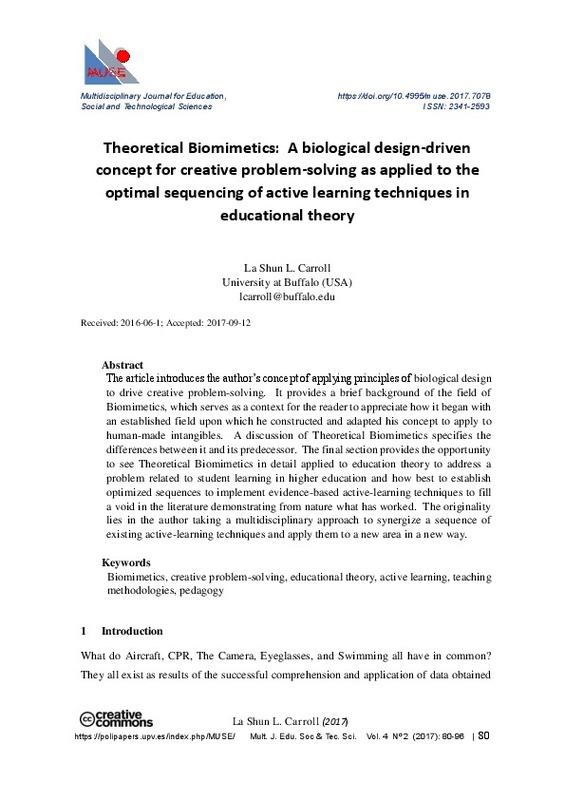JavaScript is disabled for your browser. Some features of this site may not work without it.
Buscar en RiuNet
Listar
Mi cuenta
Estadísticas
Ayuda RiuNet
Admin. UPV
Theoretical Biomimetics: A biological design-driven concept for creative problem-solving as applied to the optimal sequencing of active learning techniques in educational theory
Mostrar el registro sencillo del ítem
Ficheros en el ítem
| dc.contributor.author | Carroll, La Shun L.
|
es_ES |
| dc.date.accessioned | 2017-10-31T08:18:38Z | |
| dc.date.available | 2017-10-31T08:18:38Z | |
| dc.date.issued | 2017-09-27 | |
| dc.identifier.uri | http://hdl.handle.net/10251/90287 | |
| dc.description.abstract | [EN] The article introduces the author’s concept of applying principles of biological design to drive creative problem-solving. It provides a brief background of the field of Biomimetics, which serves as a context for the reader to appreciate how it began with an established field upon which he constructed and adapted his concept to apply to human-made intangibles. A discussion of Theoretical Biomimetics specifies the differences between it and its predecessor. The final section provides the opportunity to see Theoretical Biomimetics in detail applied to education theory to address a problem related to student learning in higher education and how best to establish optimized sequences to implement evidence-based active-learning techniques to fill a void in the literature demonstrating from nature what has worked. The originality lies in the author taking a multidisciplinary approach to synergize a sequence of existing active-learning techniques and apply them to a new area in a new way. | es_ES |
| dc.language | Inglés | es_ES |
| dc.publisher | Universitat Politècnica de València | |
| dc.relation.ispartof | Multidisciplinary Journal for Education, Social and Technological Sciences | |
| dc.rights | Reconocimiento - No comercial - Sin obra derivada (by-nc-nd) | es_ES |
| dc.subject | Biomimetics | es_ES |
| dc.subject | Creative problem-solving | es_ES |
| dc.subject | Educational theory | es_ES |
| dc.subject | Active learning | es_ES |
| dc.subject | Teaching methodologies | es_ES |
| dc.subject | Pedagogy | es_ES |
| dc.title | Theoretical Biomimetics: A biological design-driven concept for creative problem-solving as applied to the optimal sequencing of active learning techniques in educational theory | es_ES |
| dc.type | Artículo | es_ES |
| dc.date.updated | 2017-10-31T08:13:07Z | |
| dc.identifier.doi | 10.4995/muse.2017.7078 | |
| dc.rights.accessRights | Abierto | es_ES |
| dc.description.bibliographicCitation | Carroll, LSL. (2017). Theoretical Biomimetics: A biological design-driven concept for creative problem-solving as applied to the optimal sequencing of active learning techniques in educational theory. Multidisciplinary Journal for Education, Social and Technological Sciences. 4(2):80-96. https://doi.org/10.4995/muse.2017.7078 | es_ES |
| dc.description.accrualMethod | SWORD | es_ES |
| dc.relation.publisherversion | https://doi.org/10.4995/muse.2017.7078 | es_ES |
| dc.description.upvformatpinicio | 80 | es_ES |
| dc.description.upvformatpfin | 96 | es_ES |
| dc.type.version | info:eu-repo/semantics/publishedVersion | es_ES |
| dc.description.volume | 4 | |
| dc.description.issue | 2 | |
| dc.identifier.eissn | 2341-2593 | |
| dc.description.references | Angelo TA and Cross KP. (1993) Classroom assessment techniques: a handbook for college teachers, San Francisco: Jossey-Bass Publishers. | es_ES |
| dc.description.references | Arum R and Roksa J. (2011) Academically adrift: limited learning on college campuses, Chicago: University of Chicago Press. | es_ES |
| dc.description.references | Badhwar, N. (2010). Introduction to Supraventricular Tachycardia. Cardiac Electrophysiology Clinics, 2(2), 179-181. doi:10.1016/j.ccep.2010.01.001 | es_ES |
| dc.description.references | Bar-Cohen Y. (2006) Biomimetics: biologically inspired technologies, Boca Raton, FL: CRC/Taylor & Francis. | es_ES |
| dc.description.references | Bond, G. M., Richman, R. H., & McNaughton, W. P. (1995). Mimicry of natural material designs and processes. Journal of Materials Engineering and Performance, 4(3), 334-345. doi:10.1007/bf02649071 | es_ES |
| dc.description.references | Bonwell CC and Eison JA. (1991) Active learning: Creating excitement in the classroom, Washington, DC: School of Education and Human Development, George Washington University. | es_ES |
| dc.description.references | Colucci RA, Silver MJ and Shubrook J. (2010) Common types of supraventricular tachycardia: Diagnosis and management. American Family Physician 82: 942-952. | es_ES |
| dc.description.references | Johnson DW, Johnson RT and Smith KA. (1991) Cooperative learning: Increasing college faculty instructional productivity, Washington, DC: School of Education and Human Development, George Washington University. | es_ES |
| dc.description.references | Knippers, J., & Speck, T. (2012). Design and construction principles in nature and architecture. Bioinspiration & Biomimetics, 7(1), 015002. doi:10.1088/1748-3182/7/1/015002 | es_ES |
| dc.description.references | Kowey, P. R., Friehling, T. D., & Marinchak, R. A. (1987). Electrophysiology of beta blockers in supraventricular arrhythmias. The American Journal of Cardiology, 60(6), 32-38. doi:10.1016/0002-9149(87)90706-5 | es_ES |
| dc.description.references | McKeachie WJ, Pintrich, P. R., Lin, Y. G., & Smith, D. A. (1987) Teaching and learning in the college classroom: A review of the literature. Ann Arbor: National Center for Research to Improve Postsecondary Teaching and Learning. | es_ES |
| dc.description.references | Mills B, Lyman, F. T., & Davidson, N. (1995). (1995) Interactive learning in the higher education classroom (pp. 204-225). Washington, DC: National Education Association. Education: 204-225. | es_ES |
| dc.description.references | Milner-Bolotin MK, Andrzej; Rieger, Georg. (2007) Can Students Learn From Lecture Demonstrations?: The Role and Place of Interactive Lecture Experiments in Large Introductory Science Courses. Journal of College Science Teaching: p45-49. | es_ES |
| dc.description.references | Pandya, A., & Lang, E. (2015). Valsalva Maneuver for Termination of Supraventricular Tachycardia. Annals of Emergency Medicine, 65(1), 27-29. doi:10.1016/j.annemergmed.2013.07.012 | es_ES |
| dc.description.references | Rasmussen, B. H., Norberg, A., & Sandman, P. O. (1995). Stories about becoming a hospice nurse: Reasons, expectations, hopes, and concerns. Cancer Nursing, 18(5), 344???354. doi:10.1097/00002820-199510000-00003 | es_ES |
| dc.description.references | Rosenshine B. (2012) Principles of Instruction: Research-Based Strategies That All Teachers Should Know. American Educator 36: 12. Teaching ASfEB. Explicit Teaching: A Lesson Structure That Delivers Results. The Australian Society for Evidence-Based Teaching. | es_ES |








